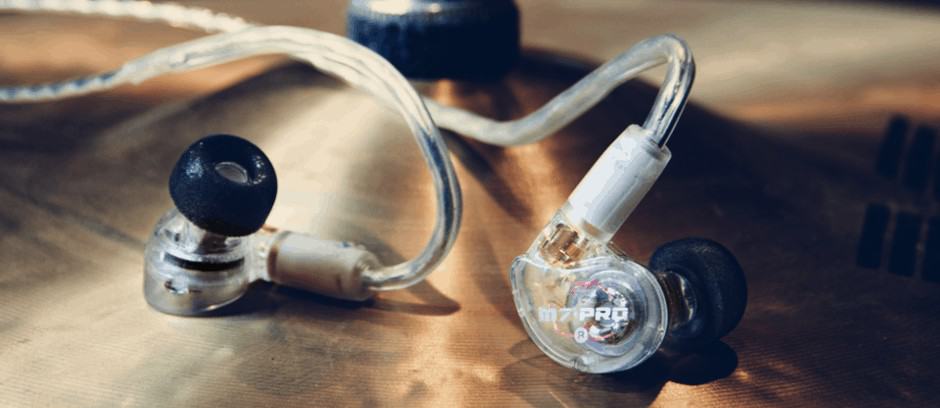Last Updated on November 23, 2021 by Danny

In-ear monitors and earbuds are two different types of headphones. So which one is better? They both have their pros and cons, but in the end, it comes down to preference.
In this article, we will compare these two products based on how comfortable they are to use on stage, sound quality, noise isolation, volume level, dynamic drivers, and price point so you can make your decision.
What’s the difference between in-ear monitors vs earbuds?
Let’s take a look at the differences between in-ear monitors vs earbuds so that you can find out what is best for you!
In-ear Monitors?

In-ear monitors, IEMs, or in-ears, are a kind of special headphones most used by musicians on stage during live performances. They belong to the category of earphones, but when compared to earbuds which have their drivers placed only on one side (usually left), IEMs have them dispersed throughout both sides so it is possible that music and sounds can be heard from all directions.
In-ear monitors are also lighter as they don’t use heavy speakers or amplifiers protruding outwards as regular headphones do – this gives an advantage for musicians who need to wear a microphone headset at the same time since there is no interference with any external mic equipment.
What are Earbuds?

Earbuds are small earphones basically somewhat similar to iem but they are inserted into the eardrums, unlike IEMs which sit on or inside the outer ear of an individual. They are typically used as a cheap alternative to in-ear monitors by musicians and singers. The problem is that earbuds don’t offer the same level of sound quality for sound engineers, producers, and performers.
Which one offers more Noise Isolation?
When it comes to blocking the external noise, in ear monitors are the clear winner. If you are looking for a way to block out the noise of your bandmates or other instruments, in ears will do that job better than any type of earbuds – this is because they allow sound to enter their microphones but not pass through into the ears. They’re designed with noise isolation technology that prevents external noises from interfering with your performance.
Earbuds on the contrary have no active Noise Isolation and just rely on passive isolation which can cause distortion at higher levels. So if you want to perform with your musicians without being distracted by them then go for an In-ear monitor device instead!
In order for earbuds to provide an adequate amount of Noise Isolation, there would need to be some sort of foam insert placed inside the ear canal (see image below) so it’s much easier and better to use an earphone with Noise Isolation.
– If you’re looking to buy a new set of earbuds, look for ones that have an inbuilt microphone so that they can be used as headphones too!
Note: For artists who want to take their music career seriously, it’s important to invest in high-quality equipment like an in-ear monitor system instead of using less expensive alternatives such as earbuds.
Which is more comfortable to wear on stage or in general?
In-ear monitors are much more comfortable to use on stage than earphones due to how well they isolate from background noise around and fit inside your ear canal. They have the edge because they’re much less likely to cause any discomfort or pain. They fit tightly into your ear canal and are designed to stay put. They also don’t create any kind of pressure points that lead to discomfort.
Earbuds, on the other hand, rest outside of the ear canal and while some people do find them comfortable for extended periods of use, many musicians report that it leads to soreness and irritation over time. Also, there is some sound leakage and you can hear what’s going on around you. This makes them not as good for performing live music, but better if you’re looking for something that provides a lot of clarity in voice chats or podcasts since it will be easier to focus only on what’s being said.
The only way around this is to swap out buds after a few hours of wear (or invest in custom in ear monitors). In contrast, IEMs can be worn all day without the risk of causing physical discomfort.
In short… in-ear are more comfortable to wear.
Which one has better sound quality?

One of the most important aspects when choosing a monitor is sound quality because it will directly affect his or her performance on stage. In order for musicians to hear themselves better while playing live on stage, they use an audio system that consists of hardware such as headphones or speakers and cables that transmit sounds from these devices into their ears.
The two types of equipment mentioned above work differently but both have distinctive pros and cons:
Earphones are smaller than headphones so they take up less space on your head thus making them more comfortable to wear during long performances. But since they come with only one speaker per side, there’s no stereo sound.
On the other hand, Iems are more expensive than earbuds but they offer better sound quality and come with two speakers per side.
Both earbuds and IEMs are designed for different purposes. If you want to choose one, think about which function the device is supposed to fulfill: if it’s studio recording or live performance then perfect sound quality becomes more important.
Earphones tend to be more popular with people who play acoustic instruments since they don’t need a lot of amplification but this doesn’t mean that iems can’t deliver good enough audio quality as well.
The only downside here is that while using these devices on stage during performances, some musicians may hear their own voice through them too loudly and thus not show up on the mixing board feed.
Also when it comes to drummers having great sound quality is the most important thing, so they can hear what’s going on. Earbuds are usually not very good at this, hence drummers need only best in-ear monitors to do a much better job.
Can you use in-ear monitors as earphones?
Yes, you can use in-ear monitors as earphones. In fact, there are some musicians who prefer to wear them and listen to music while they perform on stage so that they don’t need the sound engineer’s help with their volume control. They get more independence from being able to adjust it themselves like a singer might do when they want the backing band to turn down.
In contrast, earbuds would be uncomfortable for wearing on stage because of how tightly you have to keep your ears inside the buds or else risk accidentally pulling out an earphone during the performance which could make hearing difficult at best and disastrous at worst if performed incorrectly.
Are in ear monitors good for listening to music?
An in-ear monitor is a type of headphone that fits into your ear canal. They are often used by musicians on stage to listen to their own mix or for the band members’ instruments and vocals, which can be mixed together before being sent out through speakers.
In general, an IEM will give you more faithful representation than an earbud because they seal off sound from around them better. This means no outside sounds get in (like if someone talks too close) and there isn’t any leakage of noise back outwards towards others (such as when someone’s music leaks onto other people).
With these two points combined, this makes it easier to hear what you want even listening to music without hearing anything else disturbing you with both.
Which is bad for your ears – IEMs vs earbuds?
Some say that earbuds are bad for your ears because the speakers will connect to your eardrums which could cause hearing loss, but many people argue that this is false.
Earbud users should always be wary of how loud they play their music and try not to turn it up too high if they have sensitive ears or trouble with tinnitus.
IEMs can also fail at blocking out external noise so you must make sure that there isn’t any ambient noise when onstage, such as from a door opening unexpectedly – for example during Madonna’s performance in 2012 where her dancers came on stage unannounced!
Iems might offer better sound quality than earbuds due to their ability to block out ambient noise.
How do I know if I have IEMs or just regular earphones/earbuds?
List of signs that can indicate you have a pair of IEMs.
- IEMs have a microphone near the speaker. You are told by your sound engineer that you have IEMs on stage
- IEMs can reach into the ear canals Which will allow the sound to be much clearer than if you were wearing earbuds or using speakers.
- IEMs can also make you feel like your singing right in front of a crowd which is something that other types of monitors might not provide for some people because they’re used to it and so are desensitized by them.
- IEMs will usually be more expensive than earbuds or earphones.
It takes experience in order to know whether or not your headphones or earbuds are actually just regular ones unless there is an obvious sign such as a mic right next to the speakers.
These subtle differences make it hard at first glance when trying to figure out what type of monitors people might use while performing live but once someone has been doing this for a while they know.
Conclusion:
Every musician has different preferences when it comes to choosing between in-ear monitors vs earbuds vs headphones because each type of equipment offers its own perks. But if you want an overall opinion on which one is the best choice for performers, then I would say that iem win by far due to their excellent sound quality.
And lastly, here’s what Blake Wood had to say about this topic: “I went from using only monitor wedges as my onstage monitoring system (and hating them) to now solely using in ears.”